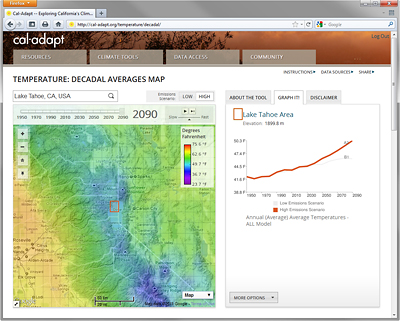New website makes California climate change science available to all
Extensive climate change research being conducted at California universities and research centers is now openly available through a public website, Cal-Adapt.org, developed at UC Berkeley and sponsored by the California Energy Commission and the California Natural Resources Agency.
June 7, 2011
Extensive climate change research being conducted at California universities and research centers is now openly available through a public website developed at the University of California, Berkeley. The announcement was made today (Tuesday, June 7) by the California Energy Commission (CEC) and the California Natural Resources Agency, the sponsoring state agencies.

The Cal-Adapt website displays projected temperature changes in area of California, including Lake Tahoe.
The website, Cal-Adapt.org, went live today and has a variety of features tailored for different types of users, including members of the general public concerned about their neighborhood or region; decision-makers, such as city planners and resource managers; and experts who want to examine data.
The information on the website comes from peer-reviewed climate change research funded by the CEC’s Public Interest Energy Research (PIER) program, which funds and oversees the Cal-Adapt website project. The site displays the research data in a variety of climate change-related scenarios and in map format, modeling various projections – such as changes in snow pack, wildfire danger and temperature – through the end of the century.
“PIER-funded projects have produced enormous amounts of data and findings related to climate change and its impact on California, but until now the data from the research has been inaccessible to a larger audience,” said Kevin Koy, manager of the Geospatial Innovation Facility (GIF), the state-of-the-art mapping and geo-location center at UC Berkeley’s College of Natural Resources, where the Cal-Adapt website was developed. Koy is co-author, with the GIF team, of an article on the development of Cal-Adapt.org published earlier this week in the journal Photogrammetric Engineering & Remote Sensing.
Koy said that Cal-Adapt is primarily a planning tool intended to benefit local climate adaption efforts, and is also designed for use by the general public. To explore climate projections, users can search specific California locations or click on an interactive map.
Sharing the data through social networking
The GIF’s Web developer, Sarah Van Wart, took a number of steps to make the site’s information accessible to non-scientists and to give users the ability to explore the data in different ways. The site includes:
- A variety of maps and charts
- Definitions of technical language
- Links to related reports and articles to help people understand the societal relevance of the research
- Social networking features, so people can share their selected views of maps through Twitter, Facebook or direct links via email
“We feel that it is important to give users the ability to share their findings from the site in as many ways as possible, including through the use of social tools,” said Van Wart. “However, what’s really most compelling about this project is the scientific data.”
Brian Galey, the data developer for UC Berkeley’s GIF team, worked on incorporating enormous amounts of information into the site.
“Cal-Adapt currently synthesizes 150 years of climate data generated from a variety of models and scenarios for carbon emissions. This gives users an opportunity to explore a wide range of possible outcomes given different potential social and economic factors,” said Galey. He said access to even more data will be provided in future versions of the site.
Galey said the scientific data he used as a source for the website are also available for download – a feature expected to be useful to researchers and experts interested in using the data to complement their own research.
Cal-Adapt provides immediate and convenient access to the latest information on the impacts of climate change in California by reflecting the research data in the visual format of California’s geography.
“Cal-Adapt will allow people to identify climate change risks in specific areas around the state,” said California Secretary for Natural Resources John Laird. “This tool will be especially beneficial to government agencies and city and county planners, as they will now have access to climate change information in a very user-friendly application.”
The various map-based tools include viewing climate change-related projections from 1950 through 2099 related to:
- Snow pack
- Wildfire risk
- Flooding vulnerability if sea level rises
- Low and high temperatures
- Amount of temperature change from now through the end of the century
- Location-specific charts and statistics showing any of the above for a selected map point.
Users can “press” a button to compare historical averages with two different scenarios: low carbon emissions and high carbon emissions.
“This feature and others like it are what make interactive Web-based maps the ideal platform to explore large, complex, location-based information,” said Koy. “Users can quickly see many options related to a particular subject. For instance, a user can view average annual temperature projections across the state, and then update the data to display only annual temperature averages for Lake Tahoe, then June Lake Tahoe averages, and then December Tahoe averages. Given the state’s many microclimates, each user can take away something completely different from the site, and there are almost limitless combinations to explore.”
The CEC and the UC Berkeley team stress that the information in Cal-Adapt does not forecast or predict specific outcomes, but rather uses modeling and mapping to display current research data.
Now that the main framework is in place, the website will be continually updated with new data provided by scientists across California as they complete peer-reviewed research projects. Many of these new projects are already under way as a part of PIER’s latest “Vulnerability and Adaptation Study.”
The UC Berkeley team will continue to improve the site’s usability as it gets feedback from various users.
Users who want more detailed information on any research at Cal-Adapt.org can go to a list of the specific studies at http://cal-adapt.org/site/publications/.